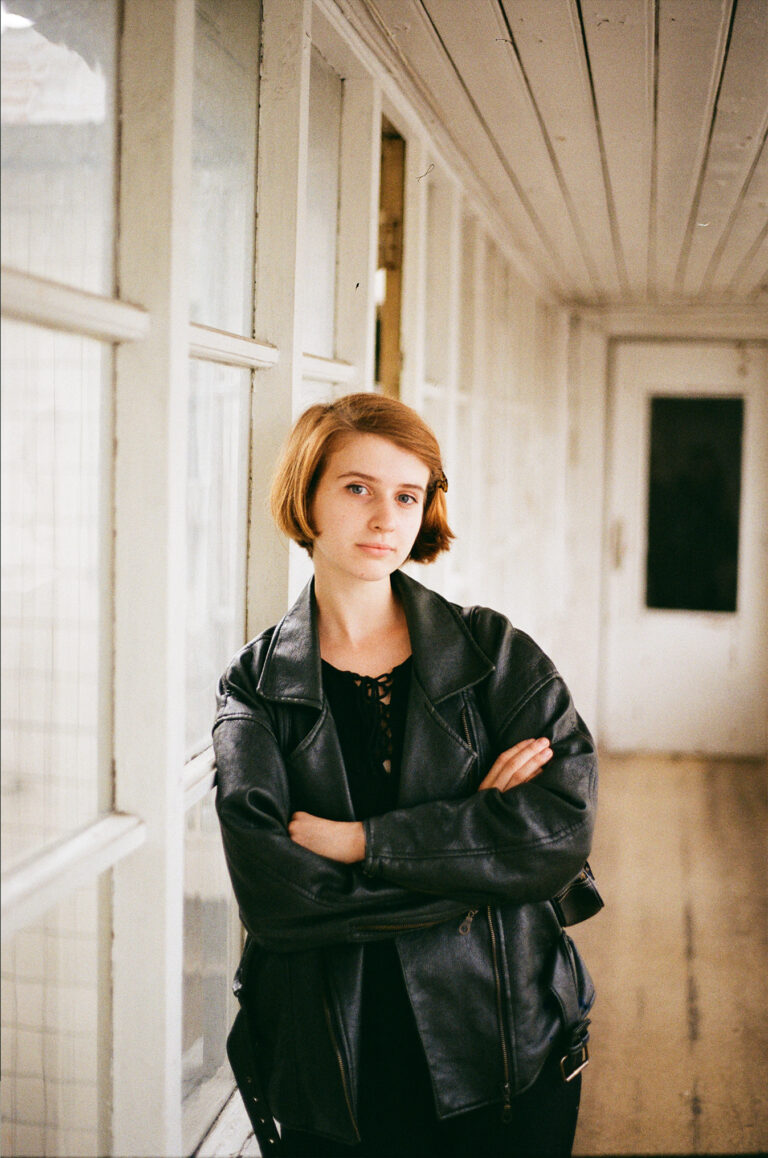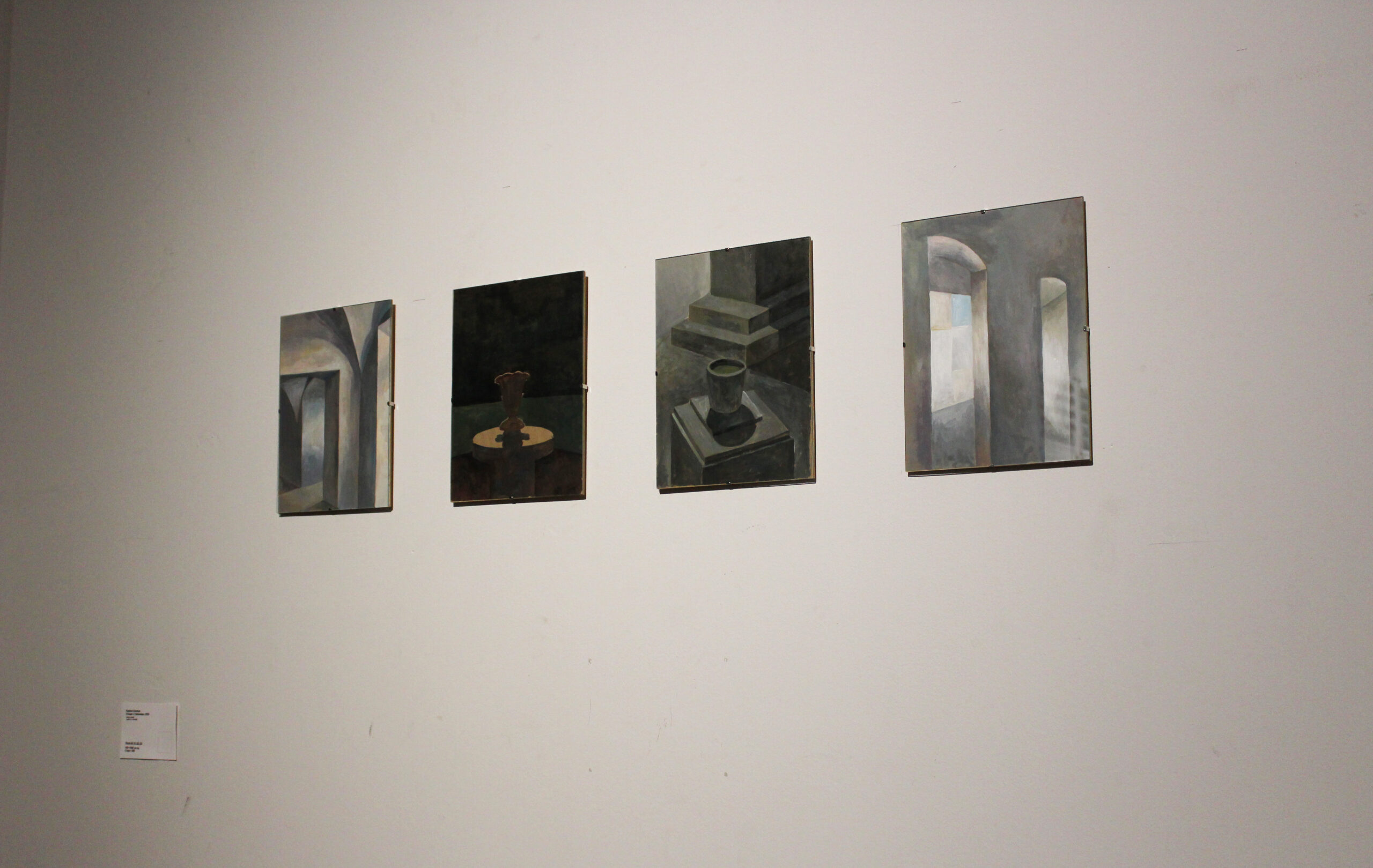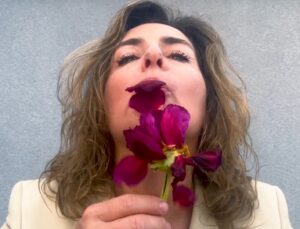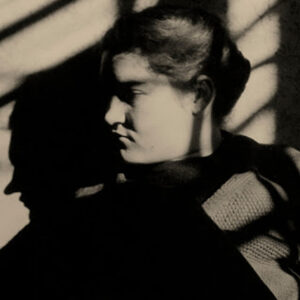Karina Synytsia / Каріна Синиця

– born in the city of Severodonetsk (Luhansk region) in 1999, and currently lives and works in Kyiv. From 2015 to 2019, she studied at the department of Fine Arts of the Kharkiv Art College, majoring in painting. In 2023, she graduated from the National Academy of Fine Arts and Architecture (NAFAA) with a degree in monumental and easel painting. Karina works with the medium of painting, as well as collage and animation. In her works, she depicts landscapes, architectural buildings and constructions, focusing on the emptiness and decay of these spaces and human emotions among them.
My work focuses on observing people and the space around them. I study the relationship between the universal and the individual, however the story of the personal takes up a larger part of my practice. Painting gives the opportunity to say goodbye to the personal, and this loss is necessary to give up the dominance of one’s own self. Instead, I become someone’s interlocutor who listens and sympathizes. The desire to sympathize intensified after a full-scale invasion.
Before that, I mostly documented spaces. I created mirages from pieces of observations, adding living beings as a staff to compositions with cities or empty rooms. While staying in Kyiv at the beginning of March 2022, I helped artists that I knew to move their works to safer places. While observing their trembling attitude towards the works, the sense of meaninglessness and uselessness of the artistic profession during the wartime began to disappear, and the conversations about the importance of telling about the war through art supported me. One of the artworks of that period is Quick, Easy Move of Memory. In the first months of the Russian full-scale invasion, it was unclear whether I would leave Kyiv. Everything was uncertain, because it was not known whether the threat would be growing. However, in this work, I copied part of my dorm room in life size on thin kraft paper. The painting of a dorm room rolls up and can easily change locations with me if needed. In a sense, the change of medium from a bulky canvas to lightweight paper was driven by the impressions I got when I was taking my friends’ artworks out of the studio and thinking about the need for mobility.
I have an experience of living under the Russian occupation for several months in Severodonetsk in 2014, but my memory of it is closed. There are only certain fragments in my brain that I can remember such as the changing of the country’s flags around the city, a russian tank near my window, and a meeting with a friend in a crater from a bomb. When will this mental reaction of trauma displacement stop working and give me my memory back? Perhaps that day I will become a completely different person (or I will understand why I am the way I am).
I don’t often mention my hometown in my works, I don’t want to highlight something “of my own”. But, for example, my work The Universe Before Our Great-Grandmothers was inspired by my childhood memories of Severodonetsk. Usually, when talking about this region, the fact that many factories, plants, and buildings were built by Europeans or Americans (so-called “western capitalists”) starting in the second half of the 19th century escaped from a Soviet person’s attention. I also didn’t know about it for a while. To tell about this part of history – the Soviet propaganda that continued to live on even among my generation in independent Ukraine, is depicted in my work as a museum display case with sand, almost like the one I saw in a museum during my annual school field trips. This showcase was placed at the beginning of the city museum at the Azot plant, and was the exhibit that began the typical story about the construction of this mono-town through the prism of the Soviet myth about Donbas as “a space of labor glory”, which was built “from nothing.”
A thematically and figuratively significant place in my practice is devoted to the manifestation of human feelings, emotional states and social aspects of life. I am talking about the common and the personal through the state of landscapes and their coexistence with the world’s architectural or natural objects. When speaking about the common, I don’t highlight individual experiences or feelings, but rather scatter symbols into a generalized landscape. That is why the works often lack a literal plot. An example of this is the series “Ultra-Naivery” which contains images of a burnt field with a playground and a destroyed room. It depicts the seemingly inadequate emotions of the traumatized person, such as hysterical laughter or jokes. I add emoticon stickers to the image, as if they are protecting the memory of the trauma with their nervous laughter.
The symbols that I create are taken from the city, from the small details that I notice, and so the composition is a collective image. I think of architecture and its elements as a silent witness of events. The work “Nowhere” depicts a resettlement, during which the characters are faced with a large concrete wall in the middle of nowhere. But they are not able to find a possibility to see the future behind this wall (although it is easy to bypass it from both sides). The image of the wall arose from a bulletin board I saw in the Kyiv industrial zone, which had a strange modernist shape with sharp corners.
Everything that I create nowadays – it is all about war. Even the sketches from a Romanian town – unpretentious motifs of parks or museum interiors – have a touch of anxiety. Perhaps, after the war, that will change. But I cannot think of the “after war” concept right now.
The text is written in collaboration with Oksana Briukhovetska (2024).
1Image: Karina Synytsia, Fast, easy memory transfer, 2022, paper, acrylic, 220x170 cm. Courtesy of the artist.2Image: Photo for the painting Fast, easy memory transfer, 2022. Courtesy of the artist.
3Image: Karina Synytsia, The universe before our great-grandmothers, 2023, paper, acrylic, 100x160cm. Courtesy of the artist.
4Image: Karina Synytsia, Scorched earth, from the series "Ultra-naivety", 2022, paper, acrylic, 55x80cm. Courtesy of the artist.
5Image: Karina Synytsia, Home absence, from the series "Ultra-naivety" 2022, paper, acrylic, 29x42cm. Courtesy of the artist.
6Image: Karina Synytsia, Wall of disbelief, from the series "Ultra-naivety", 2022, paper, acrylic, 21x29cm. Courtesy of the artist.
7Image: Karina Synytsia, Nowhere, 2022, paper, acrylic, 85x175cm. Courtesy of the artist.
8Image: Karina Synytsia, Individual suffering, 2023, paper, acrylic, 185x125cm. Courtesy of the artist.
9Image: Karina Synytsia, Tenderness cannot be a tool of protection, 2023, paper, acrylic, 29x42cm. Courtesy of the artist.
10Image: Karina Synytsia, Etudes from Timisoara, 2023, paper, acrylic. Comenduirea Garnizoanei, Muzeul Revolutiei, Parcul Civic, Statuia Decebalus Per Scorilo. Photo from the group exhibition and charity auction "soundless to deafness", NAFAA exhibition hall, 2023. Courtesy of the artist.

– Народилась в 1999 році у м. Сєвєродонецьк (Луганська обл.), живе і працює у Києві. З 2015 по 2019 рік вчилася на факультеті образотворчого мистецтва Харківського художнього училища за спеціальністю викладач живопису. Закінчила Національну академію образотворчого мистецтва та архітектури (НАОМА) за спеціальністю «монументальний та станковий живопис» у 2023 році. Працює з медіумом живопису а також з колажем та анімацією. У своїх творах змальовує ландшафти, архітектурні споруди й конструкції, в яких акцентує увагу на порожнечі, занепалості цих просторів та людських емоціях серед них.
Моя робота зосереджена на спостереженні за людським та простором навколо нього. Я вивчаю зв’язок загальнолюдського та індивідуального, втім розповідь про особисте займає більшу частину у моїй практиці. Живопис дає можливість розпрощатися з особистим, і ця втрата потрібна задля відмови від панування власного “я”. Натомість я стаю для когось співрозмовницею, яка слухає і співчуває. Бажання співчувати посилилося після повномасштабного вторгнення.
До цього я здебільшого документувала простори. Створювала міражі зі шматочків спостережень, додаючи живих істот як стафаж у композиції з містами чи порожніми кімнатами. Залишаючись у Києві на початку березня 2022 року, я допомагала знайомим художникам вивозити роботи в безпечні місця. Від спостережень за їх тремтливим ставленням до робіт, відчуття безглуздості й непотрібності мистецької професії у час війни почало зникати, а розмови про те, що розповідати про війну через мистецтво є важливим, підтримували. Одна з робіт того періоду – Швидкий, легкий переїзд пам’яті. У перші місяці після російського вторгнення, було не зрозуміло, чи покину я Київ. Все було невизначено, бо було невідомо, чи загроза зростатиме. Втім у цій роботі я скопіювала частину своєї кімнати в гуртожитку в натуральний розмір на тонкому крафтовому папері. Відтворена кімната гуртожитку скручується в рулон і може легко змінювати місце перебування разом зі мною, якщо буде потрібно. В якомусь сенсі, зміна медіуму з громіздкого полотна на легкий папір була зумовлена враженнями, які я отримала під час вивозу робіт друзів із майстерні та думками про необхідність мобільності.
У мене є досвід проживання в окупації кілька місяців у Сєвєродонецьку у 2014 році, але моя пам’ять про це закрита. В ній є лише уривки про зміни прапорів, танк під вікном та побачення з другом на вирві від бомби. Коли ця психічна реакція витіснення перестане працювати і поверне мені мою пам’ять? Напевно, того дня я стану зовсім іншою людиною (або зрозумію, чому я така, якою є).
Про своє рідне місто я згадую у роботах не часто, не хочу виокремлювати щось “своє”. Але, наприклад, робота Всесвіт до наших прабабусь була натхненна саме дитячими спогадами з Сєвєродонецька. Зазвичай, при розмові про цей регіон, з поля зору радянської людини вислизав той факт, що багато фабрик, заводів, та будівель було збудовано європейцями чи американцями (“іноземними капіталістами”) починаючи з другої половини 19 ст. Я так само деякий час не знала про це. Щоб розповісти про цей фрагмент історії – радянську пропаганду, яка продовжувала жити навіть серед мого покоління в незалежній Україні, у моїй роботі я зображую музейну вітрину з піском, майже таку, яку я бачила у музеї під час щорічних шкільних екскурсій. Ця вітрина була розміщена на початку музею міста при заводі «Азот», і була тим експонатом, з якого починалась типова розповідь про будівництво цього соцмістечка через призму радянського міфу про Донбас «як простір трудової слави», який був побудований «з нічого».
Тематично та образно значиме місце у моїй практиці займає оприявнення людських почуттів, емоційних станів та соціальних аспектів життя. Я говорю про спільне та особисте через стан ландшафтів та їх співіснування з різними архітектурними або природними об’єктами. Висловлюючись про спільне, не виділяю окремі досвіди чи почуття, а радше розкидаю символи в узагальнений ландшафт. Тому роботи часто позбавлені буквального сюжету. Прикладом цього є серія “Ультра-наївність”, в якій присутні образи спаленого поля з дитячим майданчиком та зруйнованої кімнати. Тут змальовано неадекватні на перший погляд емоції травмованого – наприклад, істеричний сміх або жарти. Я додаю до зображення стікери-смайлики, які немов захищають своїм нервовим сміхом пам’ять про травму.
Символи, які я створюю, беруться із міста, з маленьких деталей, які я помічаю, а композиція є збірним образом. Архітектуру та її елементи я мислю як мовчазного свідка подій. У роботі “Нікуди” зображено переселення, під час якого персонажі стикаються з великою бетонною стіною посеред пустоти. Але вони не знаходять можливості побачити за цією стіною майбутнє (хоча її доволі легко обійти з обох боків). Образ стіни виник із побаченої в київській промзоні дошки оголошень, яка мала дивну модерністську форму з гострими кутами.
Що б я не створювала у даний час – усе про війну. Навіть етюди з румунського містечка – невигадливі мотиви парків чи інтер’єри музеїв – мають наліт тривожності. Після війни, можливо, це зміниться. Але це “після” я не можу помислити зараз.
Текст написаний у співпраці з Оксаною Брюховецькою (2024).
1Зображення: Каріна Синиця, Швидкий, легкий переїзд пам’яті, 2022, папір, акрил, 220х170см. Зображення надано авторкою.2Зображення: Каріна Синиця, Фото до роботи Швидкий, легкий переїзд пам’яті, 2022. Зображення надано авторкою.
3Зображення: Каріна Синиця, Всесвіт до наших прабабусь, 2023, папір, акрил, 100х160см. Зображення надано авторкою.
4Зображення: Каріна Синиця. З серії “Ультра-наївність” - Випалена земля, 2022, папір, акрил, 55х80см. Зображення надано авторкою.
5Зображення: Каріна Синиця. З серії “Ультра-наївність” - Відсутність дому, 2022, папір, акрил, 29х42 см. Зображення надано авторкою.
6Зображення: Каріна Синиця. З серії “Ультра-наївність” - Стіна невіри, 2022, папір, акрил, 21x29cm. Зображення надано авторкою.
7Зображення: Каріна Синиця, Нікуди, 2022, папір, акрил, 85x175cm. Зображення надано авторкою.
8Зображення: Каріна Синиця, Індивідуальне страждання, 2023, папір, акрил, 185х125см. Зображення надано авторкою.
9Зображення: Каріна Синиця, Ніжність не може бути інструментом захисту, 2023, папір, акрил, 29х42 см. Зображення надано авторкою.
10Зображення: Каріна Синиця, Етюди з Тімішоари, 2023, папір, акрил. Comenduirea Garnizoanei, Muzeul Revolutiei, Parcul Civic, Statuia Decebalus Per Scorilo, фото з групової виставки та благодійного аукціону “беззвучно до глухоти”, виставкова зала НАОМА, 2023. Зображення надано авторкою.


